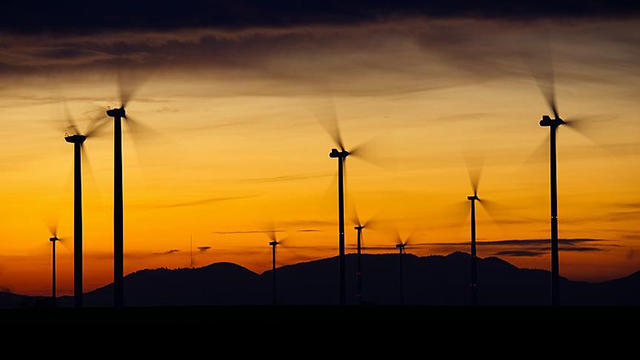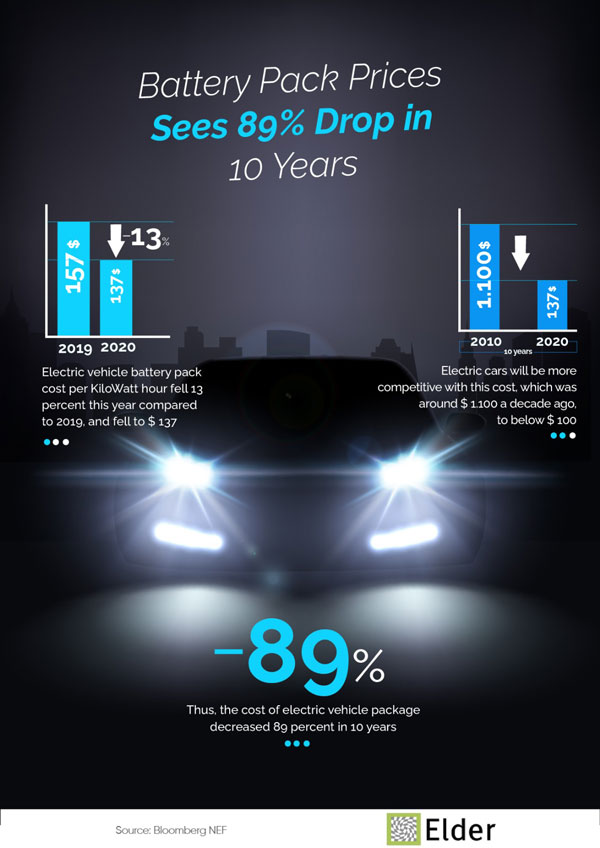
The inauguration of Turkey's first pilot lithium production plant will take place on Saturday, according to Energy and Natural Resources Minister Fatih Donmez on Wednesday.
The lithium from the Eti Maden pilot lithium production plant in the country's northwestern province of Eskisehir will be used in components in Turkey’s first domestically manufactured electric car under the stewardship of Turkey's Automobile Joint Venture Group (TOGG), Donmez explained via videoconference during the Mining Council Preliminary Workshop in Ankara.
The plant, which President Erdogan will preside over on Saturday via videoconference, will help supply the local market by eventually producing an annual average of 1,000-1,200 tonnes of lithium and compounds, which previously needed to be imported. Turkey's initial lithium production from boron sources will start on a small scale of 10 tonnes per year, and this is expected to rise to nearly 600 tonnes in the coming years, according to Donmez.
By 2030, TOGG will produce and own the intellectual and industrial property rights of five different electric vehicle models in Turkey - SUV, b-SUV, sedan, c-hatchback, and b-MPV. In June 2018, five industrial giants: the Anadolu Group, BMC, Kok Group, Turkcell, and Zorlu Holding as well as an umbrella organization, the Union of Chambers and Commodity Exchanges of Turkey, joined forces to form TOGG to produce Turkey's first domestically manufactured electric vehicle.
Source: Anadolu Agency

Turkey's Energy and Natural Resources Minister Fatih Donmez inaugurated the installment of solar energy power and Electric Vehicle (EV) charging stations at the ministry's headquarters on Friday.
Reiterating the target to make the public sector a pioneer in energy efficiency, Donmez was quoted as saying that "we have been working very hard for about a year to install solar power at our headquarters."
"As a first step in these efforts, our headquarters’ solar power and EV-charging stations are coming online today. I congratulate everyone who contributed to these projects and particularly Turkish Electricity Distribution Company (TEDAS)," Donmez said.
Solar power is projected to meet 17% of the annual energy demand of the ministry's headquarters, but taking seasonal conditions into account, this ratio might rise to 25% in spring and summer. He explained the solar power, consisting of 2,872 solar panels and covering a 5,547 square meter area, will have an installed capacity of 999 kilowatts-electric (kWe).
The project includes rooftop solar panels on seven buildings covering an area of 5,029 square meters, solar facade solar panels covering 165 square meters on two buildings and a 353 square-meter area in the car park.
In all, he confirmed that solar power will provide lighting to the dining hall, parking lot, the K, L, M, N blocks, kinder garden, health center, guesthouse, heating power station and TEIAS buildings.
Donmez also confirmed that charging stations have been installed in the parking lot in front of the TEDAS building; two 50 kW DC fast-charging stations with a charging time of nearly 1.5 hours and one 22 kW AC charging station with a 54-minute charging time. "Both stations are compatible with cars originating from Europe, the US and the Far East so our charging stations are compatible with all electric cars produced worldwide," he stressed.
Source: Anadolu Agency

Blustery winter weather helped Great Britain’s windfarms set a record for clean power generation, which made up more than 40% of its electricity on Friday.
Wind turbines generated 17.3GW on Friday afternoon, according to figures from the electricity system operator, narrowly beating the previous record set in early January this year.
High wind speeds across the country helped wind power’s share of the electricity mix remain above 40% through Saturday. Coal and gas plants made up less than a fifth of electricity generated. Melanie Onn, the deputy chief executive of Renewable UK, said: “It’s great to see our onshore and offshore windfarms have smashed another record, generating more power on a cold December day than ever before, just when we need it most.”
The record follows the “greenest” year ever for the electricity system thanks to a surge in renewable energy and sharp drop in energy demand caused by the shutdown of office blocks, restaurants and schools during coronavirus restrictions. Solar power reached a record of 9.6GW in April, which helped spur the longest coal-free streak ever of 1,629 consecutive hours, which ended in June.
Wind power generation reached a record share of almost 60% of electricity use in August as demand for power fell by more than a fifth compared with the year before. The abundance of clean electricity caused the carbon intensity of the electricity grid in March fell to an all-time monthly low of 143g of carbon dioxide per kilowatt hour, and annual figures are expected to confirm that 2020 was the greenest year.
“We expect to see many more records set in the years ahead, as the government has made wind energy one of the most important pillars of its energy strategy for reaching net zero emissions as fast and as cheaply as possible,” said Onn.
“This new record is an early Christmas present we can all celebrate.”
Source: Guardian

The Federal Energy Regulatory Commission (FERC) 2020 assessment of smart metering and demand response indicates continuing increasing penetration.
The report presents the latest available estimates of advanced meters in the US at December 2018 from the Energy Information Administration (EIA) at 86.8 million and from the Institute of Electric Innovation at 88 million. These correspond respectively to penetrations of 56.4% and 57.1%, based on a total of 154.1 million meters.
Approximately 8 million additional advanced meters were installed during 2018, similar to the previous year, and reflecting a continuing increase in the penetration by 4-5% annually. The EIA’s December 2017 penetration estimate was 51.9% and 46.8% at December 2016 (the Institute for Electric Innovation’s estimate which tends to be consistently higher was 47.6% at December 2016).
The figures also indicate the deployment of over 80 million smart meters over the past decade, with FERC’s first assessment recording 6.7 million meters with a 4.7% penetration as at December 2007.
Nevertheless, there are marked differences in penetration across the country, ranging from just 6.4% in Hawaii and 12.2% in the Northeast Power Coordinating Council region to 92.8% in the Texas reliability region.
There also are differences by customer class but in 2018, the estimated penetration for each of the three classes, residential, commercial and industrial, rose above 50% for the first time. Some of the utilities recording the greatest increases in smart metering from 2017 to 2018 included Duke Energy Carolinas with 799,000 additional meters, PacifiCorp with 517,000 additional meters and Ohio Power Company with an increase of over 483,000 meters.
The report comments that since the last assessment was issued (December 2019), electricity utilities in states across the country, including Missouri, New Jersey and New Mexico, introduced new proposals or were granted permission to submit proposals for advanced meter deployments.
In general, state regulators are requesting or requiring greater justification from utilities for investments in advanced meters, says the report.
They are requiring utilities’ advanced meter plans to clearly demonstrate how the meters will produce customer savings, identify and mitigate system outages and facilitate more dynamic rate offerings. The report finds that in 2018, customer enrolment in retail incentive-based demand response programmes and retail dynamic pricing programmes increased by 311,300 customers and 722,149 customers, respectively.
Total enrolment in both types of programmes was greater than nine million customers in 2018.
Retail dynamic rate designs continue to incorporate distributed energy resources and electric utilities are increasingly exploring their impact on demand response and dynamic pricing programs while also crafting specific rates and rate programmes for electric vehicles owned by residential customers.
From 2018 to 2019, demand resource participation in the wholesale markets increased by approximately 2,734MW, or 9%, to a total of 32,408MW. In 2019, for the first time since 2015, the Southwest Power Pool reported demand response capability in its markets and introduced tariff changes to allow for demand response resources and behind-the-meter generation to meet resource adequacy requirements.
Source: Smart Energy International

Germany’s economy and energy ministry (BMWi) has completed a number of draft bills aimed at reforming geothermal energy use, lithium mining and the handling of new power consumers, such as e-car charging stations, heat pumps and home storage systems in the power grid, Jakob Schlandt and Steven Hanke report in Tagesspiegel Background.
In line with the EU’s Renewable Energy Directive (RED II), the proposed changes to the mining law simplify and shorten the approval process for geothermal drillings. To facilitate access to lithium, which is urgently needed in battery cell production, a new classification in the mining legislation provides for planning and investment security for companies that want to mine the material, be it in stone or dissolved in deep groundwater, Hanke writes. The combination of geothermal drillings and lithium extraction from deep geothermal wells could prove especially beneficial, a research project conducted by the Karlsruhe Institute of Technology (KIT) and others has shown.
The BMWi has also proposed changes to the power grid legislation that allow distribution grid operators to reduce consumption by new large electricity users at times of peak demand. This is to ensure that the power demand of e-car charging hubs, heat pumps in buildings, night storage heaters and electricity storage systems (larger than 3.7 kilowatts) don’t endanger the overall stability of the power grid, Schlandt writes. The operators of these systems can avoid having their power supply reduced by paying extra grid fees, which would be up to five times higher than the normal fees, he reports. The ministry writes that the upcoming ramp-up of electromobility and the grid integration of other flexible consumers would lead to a “high need for grid expansion and immense costs” and could cause increasing delays in new grid connections. The new rules could save “at least 3.6 billion euros by 2030,” the ministry writes in the paper seen by the author.
While e-car associations and consumer groups criticised the idea of cutting power to charging e-cars, energy industry representatives (BDEW, E.ON) welcomed the approach, Schlandt writes. Germany has set itself the goal of becoming climate-neutral by the middle of the century. The government takes first steps to introduce (green) electricity-based solutions in areas such as mobility and heating to replace the use of fossil fuels.
Source: Clean Energy Wire

Scientists at the Lappeenranta University of Technology in Finland have found that residential off-grid PV solutions are technically feasible in northern climates only if coupled simultaneously with short-term battery storage and seasonal hydrogen storage, and if the household's peak consumption is not too high.
In the paper technical feasibility evaluation of a solar PV based off-grid domestic energy system with battery and hydrogen energy storage in northern climates, published in Solar Energy, the research team simulated a model for a similar approach in an existing single-family house in Finland with a 21 kW rooftop array and a ground source 6 kW heat pump for heating that is incorporated in the electricity consumption.
Data on hourly average power data for PV electricity generation and electricity consumption were collected for three years from January 2017 to December 2019. The two-story house is designed as a zero-energy building and has a PV system that is south and east-west oriented. It consists of a 10.4 system with a 9 kVA string inverter facing south and a 10.7 kW array with a 7 kVA inverter facing east-west.
“Undersizing the inverter compared to the PV peak power capacity is economically preferable for installations in northern locations,” the scientists said. “The capacity of the PV system is sized to the point where further improvement in self-sufficiency by increasing PV peak power is no longer feasible,” they further explained, adding that the home's self-sufficiency was found to be 36.81%, which is in line with values of all northern European countries. The average annual surplus PV power was estimated at around 200%.
In their simulation, the academics used a battery bank for short-term energy storage and for controlling peak demand, and a hydrogen tank linked to a water electrolyzer and fuel cell for seasonal storage. Surplus PV electricity is used primarily for charging the battery and only when the latter is charged is it used to power the electrolyzer. Overdemand, on the other hand, is always met first by the battery itself. “Unnecessary sudden powering on and off of the fuel cell is minimized by limiting its output power based on the battery state of charge,” they also specified.
Through sensitivity analysis and power balance analysis, the Finnish group was able to collect data on unmet power demand after storage stages and total annual hydrogen consumption and production. “Based on the simulation results, it is clear that neither a battery nor a hydrogen energy storage system alone is sufficient for year-round off-grid operation to be maintained in northern climate and insolation conditions,” the authors of the study concluded. According to their findings, using only a battery would require an “impractically” large system for this kind of project and hydrogen production alone would be wasteful due to its low round-trip efficiency. When combined together, however, the two techs could make residential off-grid solar a viable solution, although limiting high peak power consumption would be crucial.
The proposed system could only work by employing a battery with a minimum storage capacity of 20 kWh and a fuel cell and electrolyzer with an installed capacity of at least 4 to 7 kW. “Hydrogen storage capacity of about 170 kg to 190 kg is needed to maintain system operation during the winter months, thus, unless additional compressors are used, a relatively large area in a residential home would be required for physical storage of hydrogen,” the scientists affirmed. The validity of these findings, the research team went on to say, is limited to northern climates, as higher levels of solar radiation in more southern locations would mean a reduced need for seasonal storage.
Source: PV Magazine
Ten Predictions for Energy in 2021
Wood Mackenzie analysts on what we should expect in energy in the coming year, from oil markets to solar costs and coal exports to EVs With the knowledge that surprises are inevitable, but also that structural factors will continue to have an impact even during a huge shock like a pandemic, here are 10 predictions from Wood Mackenzie analysts about what to expect in 2021, and one additional thought for the more distant future:
Please click here to read the full report.
EMRA & ELDER & ODTU TEKNOKENT Energy is You Enterpreneurship Program
20 January 2021
Global DSO Event
26 - 27 January 2021
Eurelectric- e-vision: Accelerating Fleet Electrification
2 - 3 February 2021
11. Turkey Energy Summit
29 - 30 March 2021
Solarex Istanbul
01 - 03 April 2021
8th International Istanbul Smart Grids and Cities Congress and Expo (ICSG 2021)
04 - 05 June 2021
European Utility Week (Enlit Europe)
30 November - 2 December 2021

